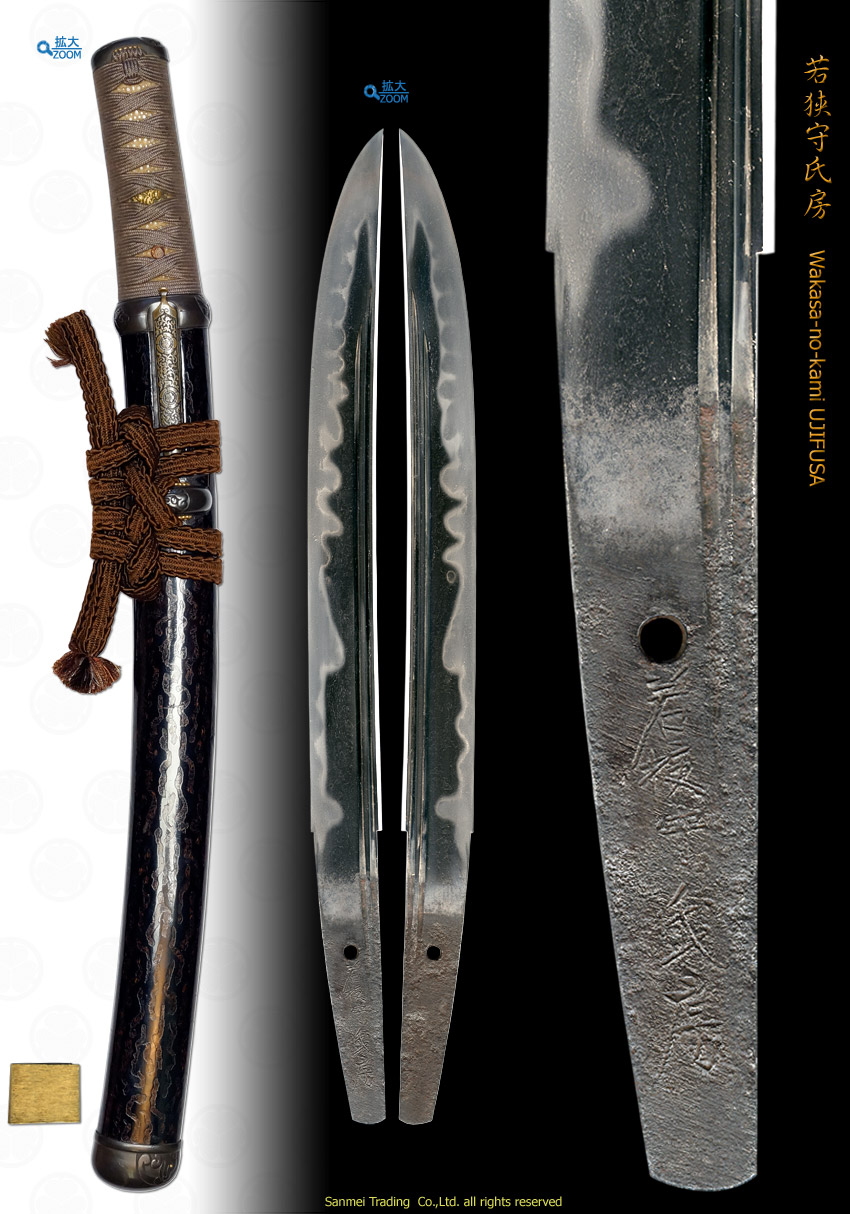with) Pine bark Hemp palm lacquered scabbard Tanto Koshirae
NBTHK(Tokubetsu Hozon) for Koshirae
Length of cutting edge 27.2cm Curvature 0.3cm Width of base 27.9mm Thickness of base 6.0mm
Forging(Hada): Forging is conspicuous Itame mixing with entwined flowing Masame partly. Steel has darkish blue impression and glows with fine Nie sparkling glitter and mottled Utsuri reflection in Hira-ji surface and darkish lines of Chikei along Itame mark activities gushes out of steel against sparkling Nie. The surface is full of moistened beauty impression.
Temper(Hamon): Hamon is fine Nie hard metal granules base, wavy Notare and flamboyant Clove and Arrow tail outline with a splash "Tobiyaki". The entire temper shape of both sides are well matched. The interior of temper is filled with moistened Nioi and Clove-feet "Ashi" radiates toward the cutting edge and Suhnagashi streams across the feet.
Temper of tip(Boshi): Boshi is irregularly Midarekomi with medium circle, Hakikake blush indication then deeply turns back that generates like a side view of Jizou stone stature.
Tang(Nakago): Nakago is in UBU original. One retaining peg hole. Sujikai (slanting left) filemarks. Back ridge of Nakago is flat and Kurijiri round heel shape. The signature in front is five large character that reads Wakasa-no-kami UJIFUSA 若狭守氏房.
The first smith UJIFUSA 氏房, real name Kawamura Kyouzaburo 河村京三郎, the initial smith name KANEFUSA 兼房, was born in the 3rd year of Tenbun (1534) as the 3rd son of Seizaemon KANEFUSA 兼房 in Gifu, Mino province. He officially was given the way of legitimate son of KANEFUSA from his elder brother Iwami-no-kami KUNIFUSA 石見守国房 in the 2nd year of Kouji (1556) to alter his given name from Kyouzabuto 京三郎 to Seizaemon 清左衛門 then moved to Seki town, Mino province.
In the 19th day, the 4th month, 13th year of Eiroku (1570) he enjoyed the officer's title of Kiyozaemon-no-shuoi 清左衛門少尉 and changed his smith name to UJIFUSA 氏房, then 3 days later he got an official district Wakasa-no-kami 若狭守 title granted by the Imperial Court.
He won the praise from the daimyo Oda Nobunaga 織田信長 then exclusively belonged to him. In the 5th year of Tensho (1577) he moved to Azuchi castle town in Oumi province along with Oda Nobunaga to work exclusively as a vassal.
After the Incident at Honnō-ji (本能寺の変, Honnō-ji no Hen) referred to the forced suicide in the 21th day, the sixth month, the 10th year of Tensho (1582) of Oda Nobunaga, UJIFUSA returned to his home town Gifu with Oda Nobutaka's 織田信孝 help then again came back to Kiyosu castle town under support of Sakuma Masakatsu 佐久間正勝. He passed away in the 11th day, the 5th month of Tensho (1590) at 57 years old.
The subject tanto is the work in his middle age around 40 years old in the peak of Warning States period while Oda Nobunaga decided crucial battle of ANEGAWA, Ishiyama Hongan-ji War and Siege of Mount Hiei. The top three character of WAKASA-no-kami 若狭守 is smaller and the rest for smith name UJI FUSA 氏房 are relatively a bit larger, that is one of his peculiar manner in his prime days. This tanto would be forged upon special demand from daimyo Oda Nobunaga himself or eigher of his faithful vassal general Samurais in Owari domain then have been treasured in generations. Ujifusa works have been highly praised as Yoki-waza-mono (supreme sharp cutting performance).
Pine bark Hemp palm lacquered scabbard Tanto Koshirae consists of :
(click HERE for entire Koshirae / HERE for higher resolution images of each fitting)
•Fuchi/Kashira, Koikuchi, Kurikata and Kojiri : Amaryu dragons design Oborogin copper alloy polish surface, unsigned.
•Menuki : dragon design, Pure gold, Yobori carving
•Futatokoro-mono (Kozuka/Kogai) : Mokkou emblem design, Brass ground, polish surface, unsigned.
•Tsuka (hilt) : White layskin, moss green (Negishi-color) silk cord, Hiramaki style lozenge wrap.
The age of Koshirae fitting would be around the latter half of Edo period.
Gold foiled habaki collar, preserved in Shira-Saya plain wood mounting.
Recent polish/Condition scale: excellent (using a scale of mint-excellent-very good-good-fair-poor).
reference sword: Katana signed Wakasa-no-kami UJIFUSA-saku The 8th month, 2nd year of Genki (1571)
reference data : Owari Tōkōfu Iwata Atou 1985 Publisher : Nagoya city Board of Education

